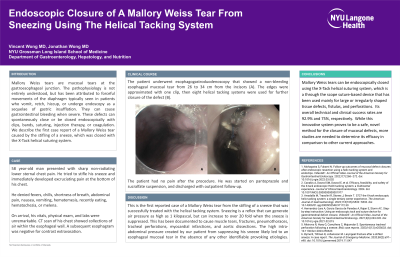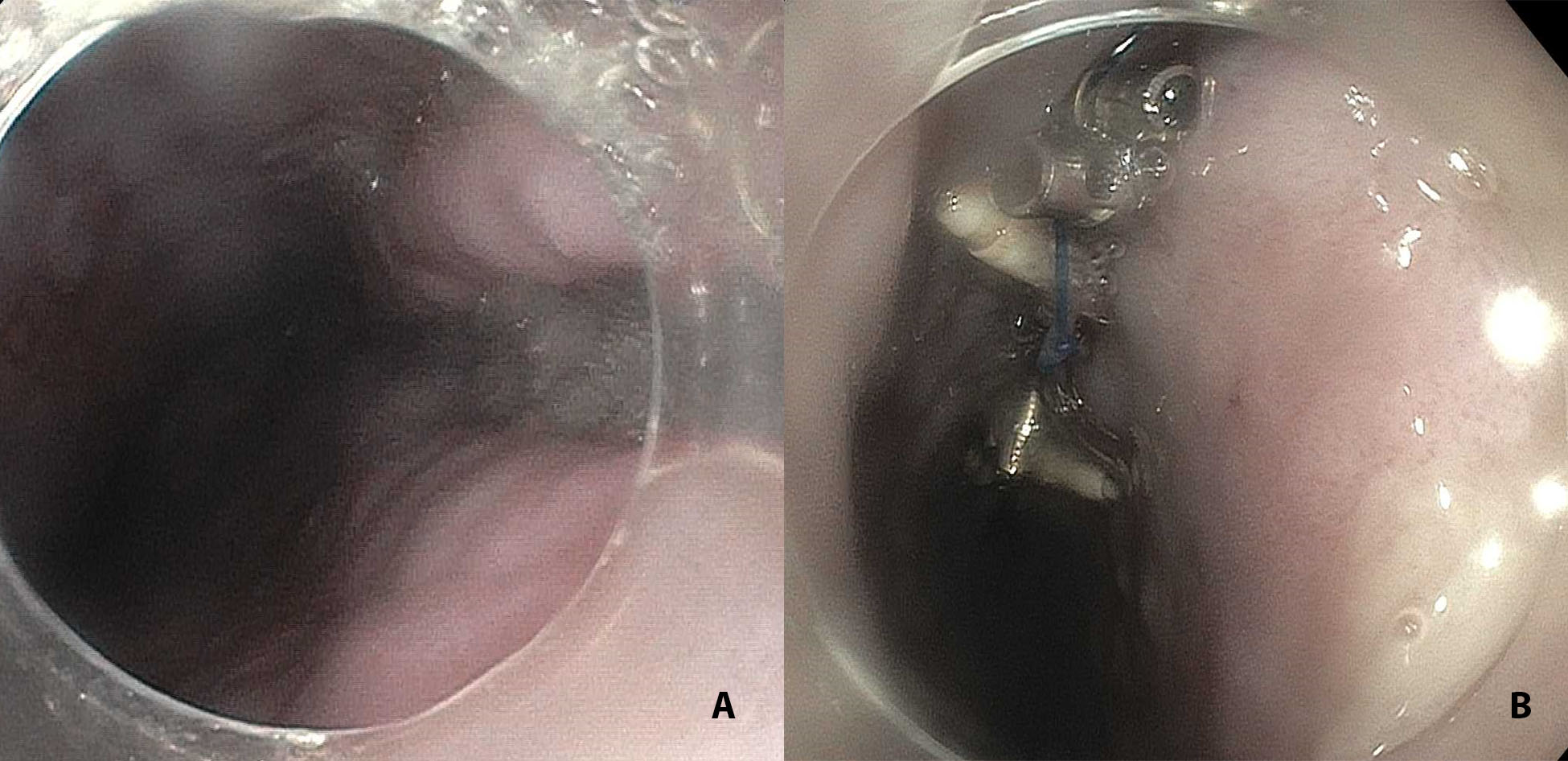Monday Poster Session
Category: Interventional Endoscopy
P2837 - Endoscopic Closure of A Mallory Weiss Tear From Sneezing Using The Helical Tacking System
Monday, October 28, 2024
10:30 AM - 4:00 PM ET
Location: Exhibit Hall E

Has Audio

Vincent Wong, MD
NYU Langone Health
Mineola, NY
Presenting Author(s)
Vincent Wong, MD, Jonathan Wong, MD
NYU Langone Health, Mineola, NY
Introduction: The pathophysiology of Mallory Weiss tears is not entirely understood, but has been attributed to forceful movements of the diaphragm typically seen in patients who vomit, retch, hiccup, or undergo endoscopy as a sequelae of gastric insufflation. These defects can be closed with clips, bands, suturing, injection therapy, or coagulation. Here, we describe the first case report of a Mallory Weiss tear caused by the stifling of a sneeze, which was closed endoscopically with the helical tacking system.
Case Description/Methods: 58 year-old man presented with sharp non-radiating lower sternal chest pain. He tried to stifle his sneeze and immediately developed excruciating pain. He denied fevers, chills, shortness of breath, abdominal pain, nausea, vomiting, or recently eating.
On arrival, his vitals, physical exam, and labs were unremarkable. CT showed collections of air within the esophageal wall. An esophagram was negative for contrast extravasation.
He underwent esophagogastroduodenoscopy that showed a non-bleeding esophageal mucosal tear from 26 to 34 cm from the incisors (A). The edges were approximated with one clip, then eight helical tacking systems were used for further closure of the defect (B).
The patient had no pain after the procedure. He was started on pantoprazole and sucralfate suspension, and discharged with outpatient follow-up.
Discussion: This is the first case report of a Mallory Weiss tear from the stifling of a sneeze that was successfully treated with the helical tacking system. Sneezing is a reflex that can generate air pressure as high as 1 kilopascal, but can increase to over 20 fold when the sneeze is suppressed. This has been documented to cause muscle tears, fractures, pneumothoraces, tracheal perforations, myocardial infarctions, and aortic dissections. The high intra-abdominal pressure created by our patient from suppressing his sneeze likely led to an esophageal mucosal tear in the absence of any other identifiable provoking etiologies.
The helical tacking system used to close the defect is a through the scope suture-based device that has been used mainly for large or irregularly shaped tissue defects, fistulas, and perforations. Up to four helical tacks are attached to a suture that approximate the tissue, which are held together by a cinch. The overall technical and clinical success rates are 92.9% and 75%, respectively. This innovative system proves to be a safe, novel method for the closure of mucosal defects; however, the current data remains limited.

Disclosures:
Vincent Wong, MD, Jonathan Wong, MD. P2837 - Endoscopic Closure of A Mallory Weiss Tear From Sneezing Using The Helical Tacking System, ACG 2024 Annual Scientific Meeting Abstracts. Philadelphia, PA: American College of Gastroenterology.
NYU Langone Health, Mineola, NY
Introduction: The pathophysiology of Mallory Weiss tears is not entirely understood, but has been attributed to forceful movements of the diaphragm typically seen in patients who vomit, retch, hiccup, or undergo endoscopy as a sequelae of gastric insufflation. These defects can be closed with clips, bands, suturing, injection therapy, or coagulation. Here, we describe the first case report of a Mallory Weiss tear caused by the stifling of a sneeze, which was closed endoscopically with the helical tacking system.
Case Description/Methods: 58 year-old man presented with sharp non-radiating lower sternal chest pain. He tried to stifle his sneeze and immediately developed excruciating pain. He denied fevers, chills, shortness of breath, abdominal pain, nausea, vomiting, or recently eating.
On arrival, his vitals, physical exam, and labs were unremarkable. CT showed collections of air within the esophageal wall. An esophagram was negative for contrast extravasation.
He underwent esophagogastroduodenoscopy that showed a non-bleeding esophageal mucosal tear from 26 to 34 cm from the incisors (A). The edges were approximated with one clip, then eight helical tacking systems were used for further closure of the defect (B).
The patient had no pain after the procedure. He was started on pantoprazole and sucralfate suspension, and discharged with outpatient follow-up.
Discussion: This is the first case report of a Mallory Weiss tear from the stifling of a sneeze that was successfully treated with the helical tacking system. Sneezing is a reflex that can generate air pressure as high as 1 kilopascal, but can increase to over 20 fold when the sneeze is suppressed. This has been documented to cause muscle tears, fractures, pneumothoraces, tracheal perforations, myocardial infarctions, and aortic dissections. The high intra-abdominal pressure created by our patient from suppressing his sneeze likely led to an esophageal mucosal tear in the absence of any other identifiable provoking etiologies.
The helical tacking system used to close the defect is a through the scope suture-based device that has been used mainly for large or irregularly shaped tissue defects, fistulas, and perforations. Up to four helical tacks are attached to a suture that approximate the tissue, which are held together by a cinch. The overall technical and clinical success rates are 92.9% and 75%, respectively. This innovative system proves to be a safe, novel method for the closure of mucosal defects; however, the current data remains limited.

Figure: (A) Deep esophageal mucosal tear seen at 26 to 34 cm from the incisors on endoscopy.
(B) Eight helical tacking systems were placed to close the mucosal defect.
(B) Eight helical tacking systems were placed to close the mucosal defect.
Disclosures:
Vincent Wong indicated no relevant financial relationships.
Jonathan Wong indicated no relevant financial relationships.
Vincent Wong, MD, Jonathan Wong, MD. P2837 - Endoscopic Closure of A Mallory Weiss Tear From Sneezing Using The Helical Tacking System, ACG 2024 Annual Scientific Meeting Abstracts. Philadelphia, PA: American College of Gastroenterology.
